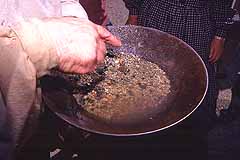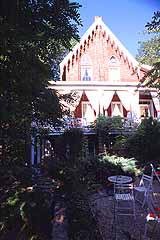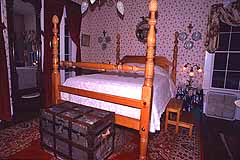Day 3
We had breakfast at the Hanford House, another lovely B-and-B in Sutter Creek that is supposedly haunted. We had delicious fresh baked muffins, fruit platters, homemade granola and crepes filled with scrambled eggs and herbs. The coffee was exceptional and served in giant coffee bowls! The prefect way to start the day.
We hopped in the Pathfinder and headed out Highway 49 to the Chili Bar Put In, close to Coloma, to take a half-day river rafting trip on the South Fork of the American River. This is another lovely drive of about 30 miles. I have to say that the Pathfinder is wonderful on country roads. It handles well and takes the curves more like a passenger sedan than a truck. The Pathfinder has a 3.3-liter, V6 engine with 168-horsepower, which gives it plenty of power to do every kind of driving -- commuting, travel, towing and off-roading. The seats are comfortable for wide hips and hold you solidly in place on twisty roads. The stereo in the Pathfinder is noteworthy as when travelling, we love to listen to CDs. We take along a box of our favorites and listen to them one after the other while on the road. The Pathfinder's AM/FM/cassette/CD 6-speaker stereo was clear and balanced and easy to hear even with the sunroof open and the power-windows rolled down.
P>Another Pathfinder feature worth mentioning is its ample rear cargo space. We were able to carry all our luggage (a ridiculous amount for a 4-day trip but we carry cameras and computers -- we're working after all) and all of our purchases.Earthtrek Expeditions provided us with our river-rafting experience. This is an activity no one should miss in their exploration of the Gold Rush Country. Not only is it fun and exhilarating -- safe for the family -- but it goes places and lets you see things important to the history of the Gold Rush that can be seen no other way.

The '49ers collected gold in three ways: they separated gold from river sediment by panning or using a cradle, Long Tom or sluice; mined hydraulically, blasting the rock and gold from the hills with water shot under massive pressure from huge nozzles called Monitors -- a VERY destructive and short lived practice; and, lastly, they dug hard rock mines to get out veins of gold buried deep in the ground.
Separating gold from river sediment was a difficult process. Panning involved scooping rocks and sediment from a riverbed with a pan that has a small channel around its bottom for catching sediment. First the large rocks were thrown out and then the gravel and silt carefully washed away by moving the pan in a circular motion allowing the water to splash out. As gold is heavier than the sediment of sand and soil it remains trapped in the channel at the bottom of the pan. Miners referred to their gold pans as their "wash bowls."
Using the cradle (or rocker) method involved placing potentially gold-bearing dirt in a hopper on the top of the cradle. Water was poured over the hopper as the cradle was rocked back and forth. This caused the dirt to wash over bars in the bottom of the cradle called "riffles." Gold was caught in the riffles and collected by the miners. This allowed the miners to process more dirt and find more gold faster than the panning method.
A Long Tom was similar to a cradle. Gold-bearing dirt was placed on a steel plate with holes in it called a "riddle." The riddle allowed small pebbles and gold nuggets to fall through while the miner plucked out the larger stones and occasionally big gold nuggets. The miners would continuously run water over the riddle while pouring on more dirt. This was a more efficient process than the cradle.
Sluicing was an even more effective form of mining. A series of riffle boxes were connected to a trough of continuously flowing water which processed even more dirt and yielded more gold.
A rafting trip takes one deep into the areas where the miners set up their camps on the river to pan and dredge for gold. It is amazing to see how much rock was moved to enable themselves to reach the deposits of gold on the river bottom. Hugh piles of large rocks line the river banks as you glide by between rapids. On the American River, Chinese workers built an amazing series of stone trails, miles long, next to the river so that the miners could bring their supplies in and hopefully take their gold out. When gold was discovered in 1848, there were only seven people from China living in California. By 1852 there were at least 20,000 with more arriving all the time. The Chinese were an important part of the Gold Rush story.
P>On the day we rafted, we were also lucky to come across some modern miners using gas-powered dredges (they had two), wet suits and power winches to extract the gold from the American River. Our guide knew the fellows doing the mining and had them give us a demonstration. They were having a bad day. They had pulled up only $500 of gold that morning. We were having trouble understanding the problem.The river rafting trip ends at the Earthtreks camp where we showered and changed our clothes. Guests on longer trips can stay in their tent-top cabins. The company offers one- and two-day trips on the South Fork of the American River as well as a variety of other trips on several of the rivers in the area. For information, call 800-229-8735 or email: trek@inforum.net.
After rafting we climbed into the Pathfinder and drove to the Marshall Gold Discovery State Historic Park, where it all began. The park is just five minutes from the rafting camp across the river. We had lunch there and were treated to a wonderful walk around the park with volunteer docents in period costume explaining the history and demonstrating how gold panning is done. For $3, the public too can pan for gold.
Sutters Mill was destroyed in a flood but a stone monument stands at the spot where the Mill once stood. A few hundred yards away is a precise replica of the Mill and the raceway. The Mill is so exact, it is easy to understand how this early technology worked and what a miracle labor-saving device it must have been. Near the Mill stands Mormon Camp, Chinese Stores, Bekearts Blacksmith shop and many other buildings of the era. This is all precisely at the spot where gold was discovered in California; the spot that set the nugget spinning -- so to speak.

The next stop on our trip was Nevada City. A quick 60-mile trip along Highway 49 from where we stopped on the American River. We passed through a number of other Gold Rush towns like Coloma, Auburn and Grass Valley with wonderfully historic downtowns, antique stores and small museums. They are all worth visiting, but time did not permit us to make many stops.
We arrived in Nevada City and went directly to the Red Castle Inn Bed and Breakfast. We'd heard about this lovely Inn from many people including the historians we had met the night before. The Inn has seven rooms all with private baths and is one of the most authentic Victorian guest homes we have ever visited. All the furnishings and fabrics are authentic from the era. The proprietress Mary Louise Weaver and her husband Conly have even been able to reacquire a few pieces of furniture owned by the Williams Family who originally built the house.

The Red Castle was built in 1860 by self-proclaimed judge John Williams and his wife for their family of 11 children, two of whom were the couple's own. The rest of the children were orphans from the wagon trains which ended their western treks in Marysville and Nevada City. The judge wanted a large house to enhance the prestige of his lawyer son, Lorring. Lorring had a brass band and was an occasional opening act for Mark Twain when he would tour the theaters in the area. The Williams were very generous people and important benefactors in the region.
If you plan to stay at the Red Castle Inn Bed and Breakfast, be aware that this Inn is indeed haunted. But don't be afraid to stay there as the ghosts are the friendliest imaginable. Though we were told many stories about the owners' and guests' experiences with the ghosts the most common encounters were by guests who experienced the sensation of being "tucked in" while they were sleeping. And many men had the feeling that someone was gently caressing their face, as if someone were brushing aside hair that had fallen across their faces. The night we were there, the other couple staying at the Inn were both "tucked in."
When the Weavers first moved into the Inn, things would go missing and then reappear. A big heavy drawer in an armoire would be pulled out -- Mary Louise kept "cracking" her hip on it. Mind you, there weren't many people working at the Inn, almost no one ever had cause to open the drawer and Conly swears he didn't leave it open. One day, Mary Louise got so angry at constantly bumping into the drawer that she said out loud, "enough is enough." And from that day forward, the drawer has never again been open for her to run into. But it still happens to Conly. The Weavers believe that Laura Jean -- the Williams family governess who died in the house -- is the ghost that leaves the drawer open. Conley thought he saw the back of a long grey dress disappearing into a room recently. And he has also heard musical instruments being played in the house when no one else was there.
A guest who came for Christmas dinner was spoken to -- actually she described it as having her "head filled with words" -- in 1989 by Caroline Williams. The guest said the voice told her a story. That her father-in-law (John Williams) was upset about someone cutting down trees on the property without permission and she was upset about it. Later a book called "So Much To Be Done" from the University of Nebraska Press came out and recounted a similar story about the Judge from Caroline's diary. As the diary had been given to an institution for preservation, neither the Weavers, the guest nor anyone from the current era would have had access to it and that particular story.
On another occasion a guest saw an entire person which then faded to the upper half of a woman. As one could not see through the apparition, the guest thought it was a living person. The guest who saw this was reputable and not a person who would have fabricated such a story.The Inn serves tea everyday at 5:00 with some refreshments. Those not staying at the Inn can join in the tea for $8.50 but reservations are a must. Occasionally on Sundays, the Inn hosts a Mark Twain tea with a well-known local character actor who often plays the role of Twain at local theaters. He converses with the guests as Twain in a 19th-century manner. The fee is $30.00 plus the $8.50 for the tea and reservations again are a must.
A special event at the Inn is their Victorian Christmas day dinner. The dinner consists of an authentic 10-course meal served over a five-hour period and is presented with a great deal of pomp and circumstance. Tables are set with heirloom china, crystal and silver. The cost for this incredible experience is about $60 plus the cost of a room. After dropping our bags, showering and changing our clothes, we drove into Nevada City. Actually it is an easy five-minute walk from the Red Castle Inn, but because it was 110 degrees outside we opted for the air-conditioned Pathfinder. During the Gold Rush, Nevada City was more populous than San Francisco. San Francisco, as we said earlier, became a ghost town at the start of the Gold Rush thanks to Sam Brannan's street-side announcement that gold was being found in the American River. Nevada City has the largest concentration of Gold Rush-era buildings in its downtown area of any town in the region. Most are located on Broad Street, lower Commercial Street and lower Main Street. The National Hotel, built between 1854 and 1857, is the oldest continuously operating hotel west of the Mississippi. Other significant buildings include the Nevada Theatre built in 1865, where Lorring Williams opened for Mark Twain, and the J.J. Ott Assay office built in 1857 where the first samples of silver ore from Comstock Lode were processed. We wandered in and out of the shops. We visited one up the hill from the National Hotel which offered an eclectic and wide selection of world music, musical and percussion instruments, clothing, jewelry and beads. There are many lovely restaurants in the area but we picked Cirino's for our dinner because it was filled with locals. We happened to be there on pizza night and consumed a lovely "white" pizza with artichoke hearts, cheese, garlic and basil. Try the roasted lamb for a succulent treat.We returned to the Inn early in order to spend some time talking to Mary Louise Weaver.




